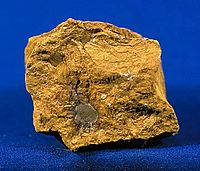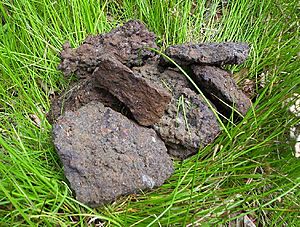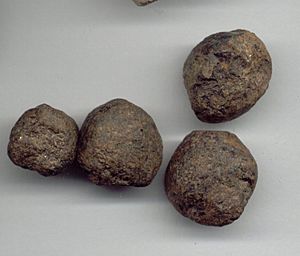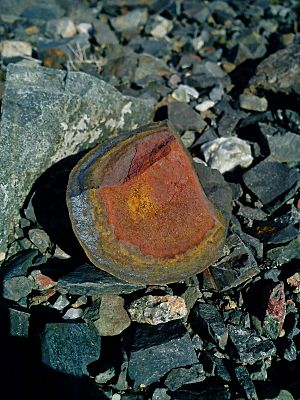Limonite facts for kids
Limonite is a mineral, from which trace amounts of iron can be extracted.
Characteristics
Limonite is relatively dense with a specific gravity varying from 2.7 to 4.3. It varies in colour from a bright lemony yellow to a drab greyish brown. The streak of limonite on an unglazed porcelain plate is always brownish, a character which distinguishes it from hematite with a red streak, or from magnetite with a black streak. The hardness is variable, but generally in the 4 - 5.5 range.
Although originally defined as a single mineral, limonite is now recognized as a mixture of related hydrated iron oxide minerals, among them goethite, akaganeite, lepidocrocite, and jarosite. Individual minerals in limonite may form crystals, but limonite does not, although specimens may show a fibrous or microcrystalline structure, and limonite often occurs in concretionary forms or in compact and earthy masses; sometimes mammillary, botryoidal, reniform or stalactitic. Because of its amorphous nature, and occurrence in hydrated areas limonite often presents as a clay or mudstone. However, there are limonite pseudomorphs after other minerals such as pyrite. This means that chemical weathering transforms the crystals of pyrite into limonite by hydrating the molecules, but the external shape of the pyrite crystal remains. Limonite pseudomorphs have also been formed from other iron oxides, hematite and magnetite; from the carbonate siderite and from iron rich silicates such as almandine garnets.
Formation
Limonite usually forms from the hydration of hematite and magnetite, from the oxidation and hydration of iron rich sulfide minerals, and chemical weathering of other iron rich minerals such as olivine, pyroxene, amphibole, and biotite. It is often the major iron component in lateritic soils. It is often deposited in run-off streams from mining operations.
Uses of limonite
One of the first uses was as a pigment. The yellow form produced yellow ochre for which Cyprus was famous, while the darker forms produced more earthy tones. Roasting the limonite changed it partially to hematite, producing red ochres, burnt umbers and siennas.
Bog iron ore and limonite mudstones are mined as a source of iron, although commercial mining of them has ceased in the United States.
Iron caps or gossans of siliceous iron oxide typically form as the result of intensive oxidation of sulfide ore deposits. These gossans were used by prospectors as guides to buried ore. In addition the oxidation of those sulfide deposits which contained gold, often resulted in the concentration of gold in the iron oxide and quartz of the gossans. Goldbearing limonite gossans were productively mined in the Shasta County, California mining district. Similar deposits were mined near Rio Tinto in Spain and Mount Morgan in Australia. In the Dahlonega gold belt in Lumpkin County, Georgia gold was mined from limonite-rich lateritic or saprolite soil. The gold of the primary veins was concentrated into the limonites of the deeply weathered rocks. In another example the deeply weathered iron formations of Brazil served to concentrate gold with the limonite of the resulting soils.
History
While the first iron ore was likely meteoric iron, and hematite was far easier to smelt, in Africa, where the first evidence of iron metallurgy occurs, limonite is the most prevalent iron ore. Before smelting, as the ore was heated and the water driven off, more and more of the limonite was converted to hematite. The ore was then pounded as it was heated above 1250 °C, at which temperature the metallic iron begins sticking together and non-metallic impurities are thrown off as sparks. Complex systems developed, notably in Tanzania, to process limonite. Nonetheless, hematite and magnetite remained the ores of choice when smelting was by bloomeries, and it was only with the development of blast furnaces in 1st century BCE in China and about 1150 CE in Europe, that the brown iron ore of limonite could be used to best advantage.
See also
 In Spanish: Limonita para niños
In Spanish: Limonita para niños







